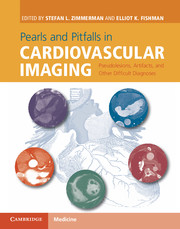 Pearls and Pitfalls in Cardiovascular Imaging
Pearls and Pitfalls in Cardiovascular Imaging from Section 1 - Cardiac pseudotumors and other challenging diagnoses
Published online by Cambridge University Press: 05 June 2015
Imaging findings
Stress cardiomyopathy, also known as Takotsubo cardiomyopathy or apical ballooning syndrome, is a condition characterized by chest pain simulating acute coronary syndrome. There are severe ventricular wall motion abnormalities with a notable absence of obstructive coronary artery disease. Stress cardiomyopathy is a transient phenomenon, thought to be related to an acute increase in sympathetic activity due to severe physical or emotional stress, and the vast majority of patients will have complete normalization of cardiac abnormalities at follow-up. Ventricular “ballooning” is the hallmark of the disease, characterized by akinesis or dyskinesis of ventricular walls during systole that is not confined to a single vascular territory (Figure 12.1). The ballooning occurs in the apex in more than 80% of patients. Mid-ventricular, biventricular, and basilar ballooning patterns can also be seen, although much less frequently. On cardiac MRI, transmural myocardial edema involving dyskinetic myocardial segments is present in the majority of patients. However, late gadolinium enhancement (LGE) is mostly absent. The prevalence of LGE reported in the literature ranges from 9–44% of patients, and this variability is thought to be related to interstudy differences in the threshold used to define late gadolinium enhancement. In the largest study to date evaluating 239 patients, when a standard threshold of 5 SD above remote myocardium was used to define LGE not a single patient had detectable LGE. When present, LGE may be patchy or transmural and will not conform to a vascular territory. When evaluated by cardiac CT, multiphase retrospectively-gated images will demonstrate the typical ventricular ballooning pattern and coronary arteries will be free from significant plaque (Figure 12.2).
Importance
The diagnosis of stress cardiomyopathy is challenging given its close resemblance to acute coronary syndrome, particularly since patients with stress cardiomyopathy may have EKG changes and elevated cardiac enzymes in addition to ventricular dysfunction. However, treatment and prognosis are very different between the two entities.
To save this book to your Kindle, first ensure [email protected] is added to your Approved Personal Document E-mail List under your Personal Document Settings on the Manage Your Content and Devices page of your Amazon account. Then enter the ‘name’ part of your Kindle email address below. Find out more about saving to your Kindle.
Note you can select to save to either the @free.kindle.com or @kindle.com variations. ‘@free.kindle.com’ emails are free but can only be saved to your device when it is connected to wi-fi. ‘@kindle.com’ emails can be delivered even when you are not connected to wi-fi, but note that service fees apply.
Find out more about the Kindle Personal Document Service.
To save content items to your account, please confirm that you agree to abide by our usage policies. If this is the first time you use this feature, you will be asked to authorise Cambridge Core to connect with your account. Find out more about saving content to Dropbox.
To save content items to your account, please confirm that you agree to abide by our usage policies. If this is the first time you use this feature, you will be asked to authorise Cambridge Core to connect with your account. Find out more about saving content to Google Drive.